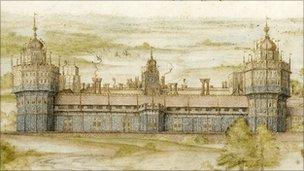Painting of Henry VIII 'lost' palace to be sold
- Published

Nonsuch Palace stood for less than 150 years before it fell into disrepair
A detailed depiction of Henry VIII's so-called lost palace is expected to fetch up to £1.2m when it is auctioned.
Construction of Nonsuch Palace on the Surrey/London border began in 1538 on the 30th anniversary of the monarch's accession to the throne.
It stood on the site of Cuddington village, near Ewell before it fell into disrepair and disappeared in the 1690s.
A 1568 watercolour of the building painted by Joris Hoefnagel is to be auctioned at Christie's in December.
The picture has not been seen in public since it was shown at The National Gallery in Washington in 1986.
'Grandest of palaces'
Christie's director and international head of Old Master and 19th Century drawings, Benjamin Peronnet, said: "This is an exceptionally rare and exciting picture.
"Not only is it one of the earliest British watercolours and a work of art of immense beauty, but it is also the most exact pictorial record of Henry VIII's great commission, Nonsuch Palace.
"Henry's determination to build the grandest of palaces was fuelled by his rivalry with Francois I of France who was a great Renaissance patron of the arts and who built the palaces at Fontainebleu and Chambord.
"Nonsuch Palace stood for less than 150 years and there are only four contemporary depictions that are known to survive.
"Of these the watercolour to be offered at Christie's is the earliest, and the only one to show a true impression of the lost palace."
Nonsuch Palace was so named because no other palace could equal it.
Henry VIII flattening the parish church of Cuddington to make way for its construction, demonstrating his dominance as head of the Church of England.